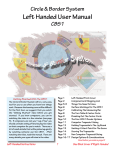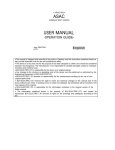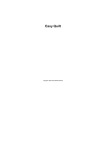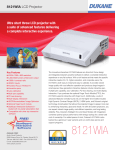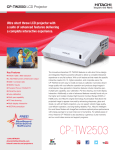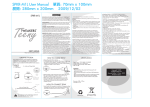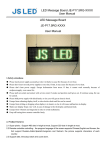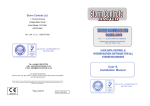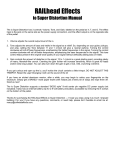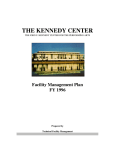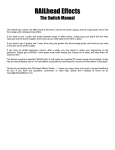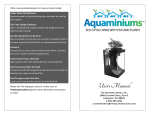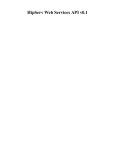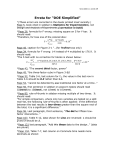Download Teeny Circle Cutter Right-handed instructions
Transcript
12 13 14 15 26 25 24 23 22 21 20 19 18 17 • Ruler - any kind will work. • Small 90° Square • Plastic Strips - you can find Plexiglas strips at a window replacement center. Usually they have scrap that is inexpensive or free. 12 13 14 15 Counterclockwise 17 18 19 20 21 22 23 24 25 26 27 Rotation 28 Cutter 4 5 6 7 8 9 10 11 12 13 14 15 16 17 18 Right Handed Setup Counterclockwise Rotation Cutter Right Handed 18 17 16 15 14 13 12 11 10 9 Setup Maxi Surface 8 7 6 5 4 3 2 2 1 2 3 4 5 6 2 1 7 8 9 10 11 12 13 14 15 16 17 18 Anchor the Circle Guide by inserting one of the black cylinders into position 1 or 2. If you are willing to wrap a few layers of masking tape around the top half of the cylinder, 2 is the Mark one corner... the mark will better placement. be your start and end point as you rotate the Turn Table 1 Insert one of the black cylinders as shown to mark the position of the Turn Table. Turn Table Do not use this cutter hole. Circle Guide 2 Use this cutter hole. Support rod should point toward you. • Portable Glass Shop • Masking Tape - ¾" wide. 11 19 List “B” 10 15 16 17 18 • Window Glass - both single and double strength glass will be helpful to practice making circles. 2 3 9 2 3 4 5 6 7 8 9 10 11 12 13 18 17 16 15 14 13 12 11 10 9 8 7 6 5 4 3 2 13 12 11 10 9 8 7 6 5 4 3 2 11 28 18 17 16 15 • Old Table Knife - used to remove taped down glass from the turn table. 8 10 20 21 22 23 • Double Stick Tape - used to hold the glass to the Turn Table when making smaller circles. 7 8 9 27 Mini & Super Mini Surface 25 • Soft Lead Pencil (wood) - will be used to make locating circles on the Turn Table. 19 You can use the Circle Guide and Turn Table anywhere on your surface but it is important to turn your Mini or Maxi Surface as shown here! 20 21 22 23 7 List “A” • Paraffin Wax - found at grocery stores in the canning supplies area. Wax is used as a lubricate and is rubbed onto the bottom of the Turn Table to improve turning. 2 3 4 5 7 8 9 10 11 12 13 14 15 16 17 18 • Turn Table & Pad - Formerly Teeny Turn Table (TT03) • Circle Guide - Formerly Teeny Circle Guide (TC01) • Glass Stop - This is the same fixture as used in the PG01B. • 2 Black Cylinders - (From CC06) • Wire Support Rod • Right Handed Instructions • Left Handed Instructions 5 4 3 2 2 3 4 5 6 2 1 Included 25 Teeny Circle System (TCS1) uccess with the Circle System will be determined by your setup, glass cutting skills and practice. List “A” has items not included that make getting started easier. List “B” has things used with the more advanced setups. 18 17 16 15 14 13 12 11 10 9 8 7 6 5 4 3 2 2 1 S Right Handed Instructions The support rod is important... make it the last thing you do before using the Circle Guide. The short end is placed in the arm as shown. Marks not used. The yellow Circle Guide is located three rows over and three rows down from the top right corner of the Turn Table... study the shaded area. To Check Your Setup: Set the scale to zero... insert a pencil into the cutter hole and spin the turn table. If your setup is correct you will draw a dot or small circle on the turn table... a larger circle means your setup is not correct. The center of the dot or circle is the center of the turn table. 1 T he concept of the Circle Guide and Turn Table is one where the glass is turned and the glass cutter is stationary. All other circle tools are the reverse. This basic difference was our way to let you use your regular glass cutter. Our design is built around the popular Toyo Glass Cutter. Their pattern head was introduced in 1978 and has remained the same through the years. The pattern head of most glass cutters will be about the same size. The cutter holes in the arm of your Circle Guide will very likely need a few minutes of tweaking to properly work with your glass cutter. Use the information below to get the best fit possible.. Your cutter must fit into the cutter hole. It is desirable to have a fit where the cutter head will slide into the arm but not be loose and allow side to side tilt. If the cutter head will not fit into the hole, you can use a small file, nail file or emery board to remove some of the plastic. The emery board will do a good job but you must first split it in half so it is narrow enough to fit the cutter hole. Because the hole is slightly tapered it is best to turn the arm over and work from the bottom. Bottom Top Right Handed Cutter Hole Remove a little plastic from each side until the cutter head fits. Right Handed Instructions Find the center of the Turn Table. Use the standard right handed setup and set the scale to zero. Place a lead pencil in the cutter hole and spin the Turn Table. If you are set up correctly you will draw a dot or small circle. The center of small circle is the center of the Turn Table. A larger circle means the setup is wrong. It is helpful to draw circles on the Turn Table with the pencil. Set the arm to 1"... draw a 2" circle. Reset the arm and draw a 3", 4" ,5" ,6" and 7" circle on the Turn Table. Correct allowance for the circle scrap is important. The idea is to score the circle and then separate the outer scrap from the circle cleanly. When you do this well, little or no grinding is needed. The breakout will be easiest if you start with a square. For a 2½" circle or larger you should make the square 1" larger than the circle. This will give you ½" of scrap on all sides. For smaller than 2½" circle make the square ¾" larger than the circle. After scoring the circle you must make the score run completely before adding any relief lines. Make 4 relief scores by starting each score near but not touching the circle. Score off the outer edge of the glass. Carefully break the relief scores to remove the scrap from the circle. Practice with single strength window glass. 2 Holding the glass to the Turn Table can be accomplished by using double stick tape or the included rubber pad. Double sided masking tape is the best type of tape to use. It is used by engravers to secure their work and by golfers to hold the grip to the club’s shaft. Other types of double sided tape will work but not quite as well. You may find it helpful to make a couple of modifications to the pad that came with your Turn Table. Cutting a small hole in the center and removing a corner allows you to easily see a center dot and corner reference mark. Size of the circle, thickness of the glass and texture are factors that will determine whether tape or pad should be used. If you are making smaller than 3" circles, the tape method shown above is usually the best choice. If the glass is single strength the tape is usually best. If the glass has texture on one side the pad method shown below is best. If the glass is smooth on both sides and the circle size is 3" or greater, either method is okay. C S callops & Trapezoids ircle & Scrap Swap 1a 1b 1c 1d The example shown here is black and white glass in 5" squares. The circles are 3¾" with a radius setting of 1⅞" (See 1e). After you score the circle and run the score you can use your Glass Shop to make accurate relief scores. This example is showing 10 panels for a mini lamp. The shape of the trapezoids can be varied to suit your needs once you understand the concept. • Draw a straight line through the center of the Turn Table. Follow example 2a above. • Pick a circle size that gives the desired arc (See 2a). • Center the trapezoid on the center line (See 2a). • Use double stick tape to hold glass (See 2c). • Use masking tape (See 2b) as a placement guide. • Mark the location of the narrow end (See 2b). • (Optional) Control the start of the score with the yellow Glass Stop (See 2b). • With right hand, place the glass cutter in the cutter hole. • With left hand, rotate the Turn Table (See 2b & 2c). 2a • Draw a straight line through the center of the Turn Table (See 1b). • Measure 2½" to the left and right at the top and bottom of the center line (See 1b). • Draw lines on the left and right side of the center line. Add masking tape to lines (See 1b). • Use a square and ruler to draw a cross line (See 1c). • Measure 2½" from the center line. Draw lines, add masking tape (See 1d & 1e). • Use the masking tape border and double sided tape to position and hold the glass (See 1e). • With your right hand, place the glass cutter in the cutter hole. • With left hand, rotate the Turn Table counterclockwise (See 1e). • After the score, follow the breakout techniques on page 2. Location Mark 2b Sta rt En d Glass Stop 1e 2c rt a St End 2 Side Tape Right Handed Instructions 3 Q uarter Circle Quilting Design This very old quilting design is called the “Drunkard’s Path”. The pieces can be arranged into dozens of other designs. With a little practice, the score and breakout is easy to do. Start with 16 three inch glass squares (8 one color, 8 another color). The quarter circles are made with a modified Turn Table and a Cutter Guide setting of 2". If this were a full circle its diameter would be 4". If you put four 3" squares together you have a 6" square. 3a Glass Stop Removed Corner Scoring the Glass • (Review 3e) A small piece of double sided tape is used to hold the glass in place. The Cutter Guide arm is set to 2". (Optional) Adjust the yellow Glass Stop so the cutter wheel is starting on the edge of the glass. • (Right hand) Place your glass cutter in the Cutter Guide. • (Left hand) Rotate the Turn Table counterclockwise until the cutter falls off the edge of the glass (See 3e). Running the Score The shape of the score will make the breakout prone to flares at the start and end of the score. To decrease the chance of flares you can do the following: • Turn the scored side down on the surface (See 3g). • Using your finger or thumb push down on the glass with steady pressure in one of the two marked areas (See 3g). Press until you see or hear the glass break... do both marked areas. If the pieces have not separated, press in the middle of the score line to complete the break. Start 90 End 2 Side Tape 3d 3c 3b 90 Modifying the Turn Table • Position the 3" glass square as shown in 3b. Be sure the corner of the glass is on the Turn Table center. • in 3c a border is created using plastic strips. Strips are held in place with double sided tape. Be sure the strip thickness is the same or thinner than the glass. • In 3d the 90° Fast Angle from the PG01B is used. If you have this fixture it is the better option. Use double sided tape to hold the Fast Angle to the Turn Table. • (Optional) Use the yellow Glass Stop to control the starting point of the score (See 3e). To use the Glass Stop you must remove a corner from the Turn Table (See 3e & 3f). Because the corner will never be needed, this modification will not reduce the function of the Turn Table. Use scissors or utility knife to remove the corner. 3e Start 3f Press Down Here End 90 Press Down Here 3g Scored Side Up Right Handed Instructions 4 Scored Side Down





